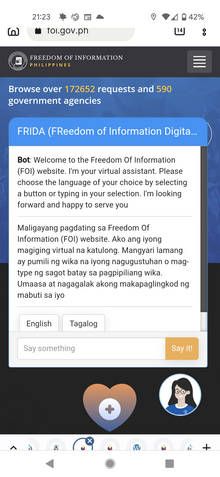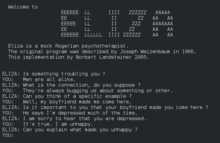
Back Kletsbot Afrikaans بوت دردشة Arabic Çatbot Azerbaijani Chatbot BAR Чатбот Bulgarian चैटबॉट Bihari চ্যাটবট Bengali/Bangla Čet-bot BS Bot de conversa Catalan چاتبۆت CKB


| Part of a series on |
| Machine learning and data mining |
|---|
A chatbot (originally chatterbot)[1] is a software application or web interface designed to have textual or spoken conversations.[2][3][4] Modern chatbots are typically online and use generative artificial intelligence systems that are capable of maintaining a conversation with a user in natural language and simulating the way a human would behave as a conversational partner. Such chatbots often use deep learning and natural language processing, but simpler chatbots have existed for decades.
Although chatbots have existed since the late 1960s, the field gained widespread attention in the early 2020s due to the popularity of OpenAI's ChatGPT,[5][6] followed by alternatives such as Microsoft's Copilot and Google's Gemini.[7] Such examples reflect the recent practice of basing such products upon broad foundational large language models, such as GPT-4 or the Gemini language model, that get fine-tuned so as to target specific tasks or applications (i.e., simulating human conversation, in the case of chatbots). Chatbots can also be designed or customized to further target even more specific situations and/or particular subject-matter domains.[8]
A major area where chatbots have long been used is in customer service and support, with various sorts of virtual assistants.[9] Companies spanning a wide range of industries have begun using the latest generative artificial intelligence technologies to power more advanced developments in such areas.[8]
- ^ Cite error: The named reference
Mauldinwas invoked but never defined (see the help page). - ^ "What is a chatbot?". techtarget.com. Archived from the original on 2 November 2010. Retrieved 30 January 2017.
- ^ Caldarini, Guendalina; Jaf, Sardar; McGarry, Kenneth (2022). "A Literature Survey of Recent Advances in Chatbots". Information. 13 (1). MDPI: 41. arXiv:2201.06657. doi:10.3390/info13010041.
- ^ Adamopoulou, Eleni; Moussiades, Lefteris (2020). "Chatbots: History, technology, and applications". Machine Learning with Applications. 2: 100006. doi:10.1016/j.mlwa.2020.100006.
- ^ Hu, Krystal (2 February 2023). "ChatGPT sets record for fastest-growing user base - analyst note". Reuters.
- ^ Hines, Kristi (4 June 2023). "History Of ChatGPT: A Timeline Of The Meteoric Rise Of Generative AI Chatbots". Search Engine Journal. Retrieved 17 November 2023.
- ^ "ChatGPT vs. Bing vs. Google Bard: Which AI is the Most Helpful?".
- ^ a b Gupta, Aman (21 March 2023). "GPT-4 takes the world by storm - List of companies that integrated the chatbot". mint.
- ^ "2017 Messenger Bot Landscape, a Public Spreadsheet Gathering 1000+ Messenger Bots". 3 May 2017. Archived from the original on 2 February 2019. Retrieved 1 February 2019.